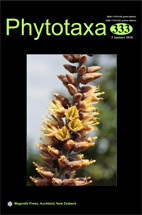Abstract
Limonium latebracteatum is a plant species from the central and northeastern Iberian Peninsula, characterised by an inner bract wider than long, glaucous leaves, and wide petioles, which belongs to the Limonium delicatulum group. The L. delicatulum group is a complex group formed by around fifteen Iberian and Balearic species, including endemisms with narrow distributions, which is highly diversified in the Mediterranean territories of the Iberian Peninsula. The species in that group are similar each other and occasionally they are not well-delimited morphologically. In this framework, a taxonomic revision of L. latebracteatum and close species in the Iberian Peninsula has been carried out to clarify the taxonomy of L. latebracteatum and L. carpetanicum. This revision has been based on morphological features and supported by ordination analyses such as Principal Component Analysis (PCA) and Linear Discriminant Analysis (LDA). In addition, a classification tree was performed to support these analyses. As a result of this study, L. latebracteatum has been separated in two different
species: L. latebracteatum and L. admirabile, a new species endemic to Albacete province which is described here. Finally, a diagnostic key is provided for the L. delicatulum group to allow identification of the species in this group.

